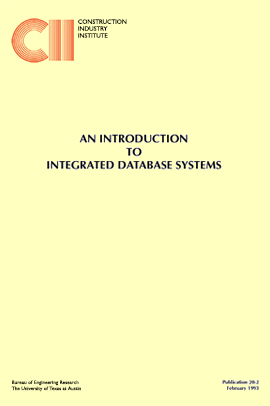
An Introduction to Integrated Database Systems
Electronic technology in the construction industry today is entering a new era of advancement and sophistication. Management and implementation of the new technologies are becoming integral parts of company strategic plans. One emerging concept is the integration of systems and data structured in a manner compatible with the sharing of information both internally and externally. This philosophy is referred to as Integrated Database Systems. Companies and the industry are being driven in this direction by the potential for dramatic improvements in productivity. This technology holds the promise of speeding the engineering, procurement, construction, operation and maintenance process, while improving the quality of and access to information.
Who should read this publication? Industry participants are aware that the electronic data management arena holds major issues for construction. CII has established broad industry goals for the Year 2000: reduced costs, reduced schedules, and improvment in safety. These goals cannot be achieved, the task force believes, without a clear understanding of electronic data issues, including integrated databases systems.
This CII publication provides examples of approaches and ideology in the implementation of integrated database systems within our industry. The examples display some of the issues that are being faced in the selection of hardware and software platforms in a changing electronic environment. A pressing need is for standardization—to allow for the internal as well as external sharing of information. Today, this issue is being addressed through development of ANSI standards for Electronic Data Interchange (EDI) and additional standards under the Standard for the Exchange of Product Data (STEP) effort.
Different paths are available to achieve data integration, barriers can be overcome, and hardware and software integration is taking place through the use of file conversion techniques and the synthesis of computer graphics with integrated databases. The technological result is the advent of truly advanced capabilities that will enhance productivity.
Benefits include improved access to project data, more efficient hardware utilization, accelerated drawing production, reduced rework, the ability to exchange information in digital format, and visual access to project information.
Additional information may be obtained in two companion CII publications produced by the Electronic Data Management Task Force: Publication 20-1, EDI: Concepts and Applications and Publication 20-3, Achieving an Integrated Data Environment: A Strategic Initiative
Electronic technology in the construction industry today is entering a new era of advancement and sophistication. Management and implementation of the new technologies are becoming integral parts of company strategic plans. One emerging concept is the integration of systems and data structured in a manner compatible with the sharing of information both internally and externally. This philosophy is referred to as Integrated Database Systems.
An integrated database is a concept of organizing, storing, and managing all electronic data relating to a major activity or area of interest (a project, for example) in such a fashion that data is entered and stored once and then accessed and utilized by multiple users and applications. Primary benefits include reduced errors, elimination of duplicate effort and input, and shorter cycle times.
{^widget|(widget_displayname)WatermarkImage|(name)WatermarkImage|(image)%7e%2fCII%2fmedia%2fPublications%2f20_2Figure2.PNG%3fext%3d.png|(width)|(height)^}The research provides examples of approaches and ideology in the implementation of integrated database systems within our industry. The examples display some of the issues that are being faced in the selection of hardware and software platforms in a changing electronic environment. A pressing need is for standardization – to allow for the internal as well as external sharing of information.
Barriers to adoption still exist both internal and external to any given company. Internal barriers can be mitigated by creating a good strategic plan, selecting the appropriate technology, and having a firm commitment and support by managers. External barriers will need to be addressed by the industry over time and include: lack of common commodity codes, graphics, and other electronic standards. (RS20-2, p. 19)



